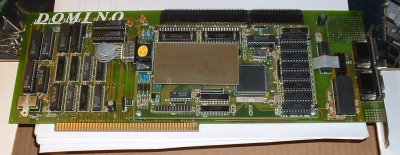Innholdsfortegnelse
Domino
The Domino is one of the first graphic cards for Amiga computers who were equipped with a so called 'Workbench Emulation'. This means that new screen modes are created by the driver software which then can be used by system compliant applications either in a window on workbench or opening their own screens without needing to be changed.
It was developed by Village Tronic on behalf of X-Pert Computer Services. The workbench emulation was developed by Thomas Sontowski (as far as known 1)). The underlying liraries which contain the actual graphic functions were created by David Göhler and Klaus Burkert.
The card is a combination of a PC ISA bus card with a Tseng ET4000 graphic controller using 1MB RAM and a second board which contains the conversion hardware for the Zorro-Bus of the Amiga and a display switch.
The cards Digital to analog converter (DAC) supports 16, 256 und 32768 color modes as a plain frame buffer. A Blitter was first introduced for a later version (W32) of the ET4000 chip.
The picture on right hand side show a prototype with a 24 bit DAC on an adapter board. This version was never sold.
Technical Specs
Tseng ET4000AX
- 1MB DRAM ~ 53MB/s memory bandwith
- internal ISA Bus
- Display switch (optional, Siliconix DG894)
- 89,8Mhz maximum pixel clock
Drivers
- Picasso96
- CyberGraphX V2
- EGS
- original Software which came with the card


